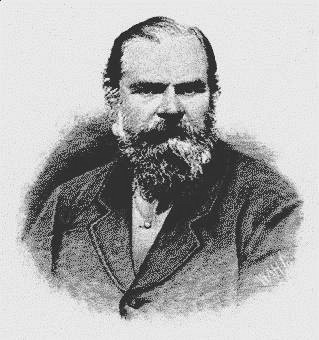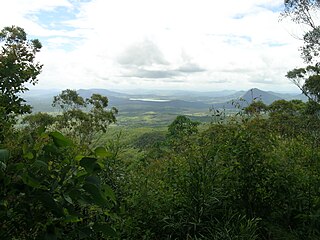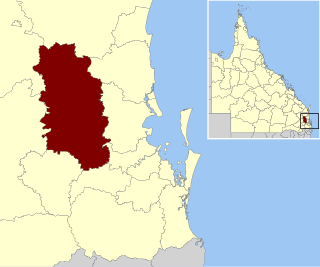
Queensland is a state in northeastern Australia, the second-largest and third-most populous of the Australian states. It is bordered by the Northern Territory, South Australia and New South Wales to the west, southwest and south respectively. To the east, Queensland is bordered by the Coral Sea and the Pacific Ocean; to its north is the Torres Strait, separating the Australian mainland from Papua New Guinea, and the Gulf of Carpentaria to the north-west. With an area of 1,723,030 square kilometres (665,270 sq mi), Queensland is the world's sixth-largest subnational entity; it is larger than all but 16 countries. Due to its size, Queensland's geographical features and climates are diverse, including tropical rainforests, rivers, coral reefs, mountain ranges and sandy beaches in its tropical and sub-tropical coastal regions, as well as deserts and savanna in the semi-arid and desert climatic regions of its interior.

Ipswich is a city in South East Queensland, Australia. Situated on the Bremer River, it is approximately 40 kilometres (25 mi) west of the Brisbane central business district. The city is renowned for its architectural, natural and cultural heritage. Ipswich preserves and operates from many of its historical buildings, with more than 6000 heritage-listed sites and over 500 parks. Ipswich was founded in 1827 as a mining settlement. The suburb of the same name is its central business district. In the 2021 census, the population of the urban area of Ipswich was 115,913 people.
Murri is a demonym for Aboriginal Australians of modern-day Queensland and north-western New South Wales. For some people and organisations, the use of Indigenous language regional terms is an expression of pride in their heritage. The term includes many ethno-linguistic groups within the area, such as the Kamilaroi (Gamilaraay) and Yuggera (Jagera) peoples.

The Lockyer Valley is an area of rich farmlands that lies to the west of Brisbane, Queensland, Australia and east of Toowoomba. The Lockyer Valley is rated among the top ten most fertile farming areas in the world, and the intensively cultivated area grows the most diverse range of commercial fruit and vegetables of any area in Australia. The valley is referred to as "Australia's Salad Bowl" to describe the area as one of Australia's premium food bowls.

Frederick Walker was a British public servant of the Colony of New South Wales, property manager, Commandant of the Native Police, squatter and explorer, today best known as the first Commandant of the Native Police Force that operated in the colonies of New South Wales and Queensland. He was appointed commandant of this force by the NSW government in 1848 and was dismissed in 1854. During this time period the Native Police were active from the Murrumbidgee/Murray River areas through the Darling River districts and into what is now the far North Coast of NSW and southern and central Queensland. Despite this large area, most operations under Walker's command occurred on the northern side of the Macintyre River. Detachments of up to 12 troopers worked on the Clarence and Macleay Rivers in NSW until the early 1860s and patrols still extended as far south as Bourke until at least 1868. After his dismissal from the Native Police, Walker became involved in the pastoral industry as a squatter, as well as organising a private native police force and leading a number of expeditions into Northern Queensland.

Fassifern Valley is a valley of the Scenic Rim in South East Queensland. Towns found in the valley include Harrisville, Kalbar, Roadvale, Warril View and Aratula. Fassifern Valley is known as a carrot-producing area, as well as for growing potatoes, onions, pumpkins and melons. It is one of four vegetable-producing regions in southern Queensland, the others being the Lockyer Valley, the eastern Darling Downs and the Granite Belt.

The Somerset Region is a local government area located in the West Moreton region of South East Queensland, Australia, about 100 kilometres (62 mi) northwest of Brisbane and centred on the town of Esk. It was created in 2008 from a merger of the Shire of Esk and the Shire of Kilcoy. It is commonly known as the Brisbane Valley, due to the Brisbane River which courses through the region, although significant parts of the region lie outside the hydrological Brisbane Valley itself.
The Turrbal are an Aboriginal Australian people from the region of Brisbane, Queensland. The name primarily refers to the dialect they speak, the tribe itself being alternatively called Mianjin/Meanjin/Meeanjin. Mianjin is also the Turrbal word for the central Brisbane area. The traditional homelands of the Turrbal stretch from the North Pine River, south to the Logan River, and inland as far as Moggill, a range which includes the city of Brisbane.

The Australian frontier wars were the violent conflicts between Indigenous Australians and primarily British settlers during the colonial period of Australia.

The Flinders Peak Group is an unnamed range of hills located on the northern edge of the Scenic Rim Region, south west of Logan City and south east of the City of Ipswich in South East Queensland, Australia. The summit in the Range is Flinders Peak reaching 680 metres (2,230 ft) above sea level.

The Jagera people, also written Yagarr, Yaggera, Yuggera, and other variants, are the Australian First Nations people who speak the Yuggera language. The Yuggera language which encompasses a number of dialects was spoken by the traditional owners of the territories from Moreton Bay to the base of the Toowoomba ranges including the city of Brisbane.

Rangeville is a residential locality in Toowoomba in the Toowoomba Region, Queensland, Australia. In the 2021 census, Rangeville had a population of 8,668 people.
Turrbal is an Aboriginal Australian language of the Turrbal people of the Brisbane area of Queensland.

The Quandamooka people are Aboriginal Australians who live around Moreton Bay in Southeastern Queensland. They are composed of three distinct tribes, the Nunukul, the Goenpul and the Ngugi, and they live primarily on Moreton and North Stradbroke Islands, that form the eastern side of the bay. Many were pushed out of their lands when the English colonial government established a penal colony near there in 1824. Each group has its own language. A number of local food sources are utilised by the tribes.

Domville is a rural locality in the Toowoomba Region, Queensland, Australia. In the 2021 census, Domville had "no people or a very low population".
Lockyer is a rural locality in the Lockyer Valley Region, Queensland, Australia. In the 2016 census, Lockyer had a population of 95 people.
The Border Police of New South Wales was a frontier policing body introduced by the colonial government of New South Wales with the passing of the Crown Lands Unauthorised Occupation Act 1839.
The following is a timeline of the history of the city of Brisbane, Queensland, Australia.
Multuggerah was an Aboriginal Australian leader and resistance fighter of the Ugarapul nation from the Lockyer Valley in Queensland. He was an important warrior and negotiator, bringing numerous Aboriginal clans together in an armed resistance against the 99th (Lanarkshire) Regiment of Foot, squatters and the squatters' servants and other workers in the 1840s.











